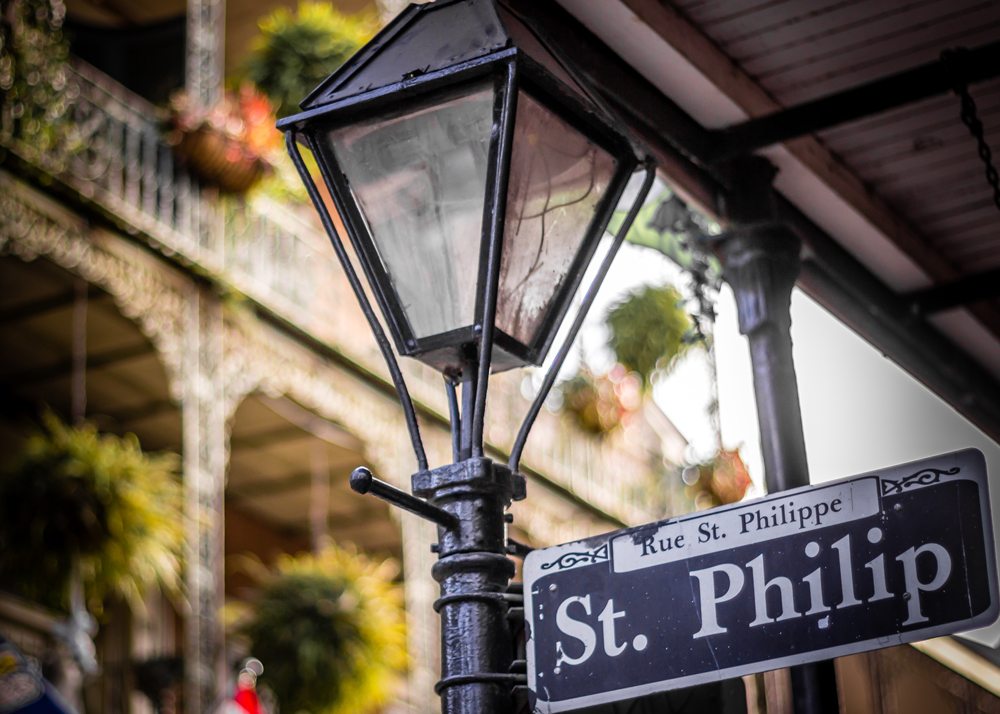History of the French Quarter

Founded as a military-style grid of seventy squares in 1718 by French Canadian naval officer Jean Baptiste Bienville, the French Quarter of New Orleans has charted a course of urbanism for parts of four centuries. Bienville served as governor for financier John Law’s Company of the Indies, which in naming the city for the Regent Duc d’Orleans sought to curry Court favor before failing spectacularly in the “Great Mississippi Bubble.”
The French Period legacy endures in the town plan and central square, the church of St. Louis, the Ursuline Convent and women’s education, the old-regime street names such as Bourbon and Royal, the charity hospital, and a mixed legacy of Creole culture, Mardi Gras, and the important effects of African enslavement combined with a tolerant approach to free persons of color.
The “Spanish” Quarter
In 1762, the indifferent Louis XV transferred Louisiana to his Bourbon cousin Charles III of Spain. Emboldened by a period of Spanish vacillation in taking power, Francophile colonists staged a revolution in 1768, summarily squelched by Alejandro O’Reilly with a firing squad at the Esplanade fort.
Spanish rule lasted for four decades, imparting a legacy of semi-fortified streetscapes, common-wall plastered brick houses, and walled courtyards used as gardens and utility spaces with separate servants’ quarters and kitchens. Olive oil cooking and graceful wrought iron balconies, hinges and locks in curvilinear shapes, and strong vestiges of civil law remain from the Spanish presence.
After the great fires of 1788 and 1794, The Cabildo, or town hall, The Presbytere, or priests’ residence, and ironically named “French” Market arose to take a permanent place in French Quarter history.
After the Louisiana Purchase
The 1803 Louisiana Purchase, signed within the elegant salon of the Cabildo, transferred the colony to the United States, inaugurating an era of prosperity. American culture made slow inroads, largely owing to the arrival of 10,000 refugees from the French and Haitian Revolutions and Napoleonic wars.
The “glorious victory” of the 1815 Battle of New Orleans, led by Indian fighter and future president Andrew Jackson over numerically superior British forces, fixed loyalty to the American nation. The French Quarter’s golden era followed as cotton, sugar and steamboats poured into the city. American, Irish, German, African, and “Foreign French” immigrants swelled the population, creating a heterogeneous matrix of culture, language, religion, and cuisine.
Civil War to WPA
Civil War and Reconstruction, played out politically on the streets of the French Quarter, put an end to prosperity and inaugurated a tug of war between reform and machine factions as the Old Square declined. Creoles moved to Esplanade and later Uptown, and famine-driven Sicilian immigrants found cramped lodging in the grand spaces of French Quarter mansions of the 1890s.
The birth of jazz in the 1900s in nearby Storyville nurtured musical legends Jelly Roll Morton, Louis Armstrong, Buddy Bolden, King Oliver, Bunk Johnson, Nick LaRocca, and other jazz and ragtime greats.
By 1920, the legacy of a storied past first celebrated by George Washington Cable and Lafcadio Hearn in the 1880s attracted writers and artists in increasing numbers. William Faulkner, Sherwood Anderson, Tennessee Williams, and Truman Capote were among American writers attracted to the French Quarter for its freewheeling urbanism, quaint surroundings and creative stimulus, even as the building stock declined.
The Vieux Carré Commission
Nineteen thirty-six marked the onset of regulatory controls in the form of the state-sanctioned Vieux Carré Commission. Residents dug in to preserve the quaint and distinctive character of the old Quarter as art galleries and antique stores sprouted on Royal Street and brassy Dixieland-style jazz flourished in Bourbon Street nightclubs and strip joints.
By 1960, with traditional jazz in decline, Preservation Hall emerged to serve beleaguered musicians. Here Sweet Emma Barrett and other traditional and largely African-American musicians found appreciative and sober audiences. Today, these and other preservation battles are the order of the day as increasing pressure from a tourist-driven economy lures some 10 million visitors annually to the time and foot-worn streets of the Vieux Carré.
Sally Reeves is a noted writer, historian, translator, and archivist. She is known for her work in the New Orleans Notarial Archives as “Louisiana’s premier archivist” and her publications on New Orleans history.






